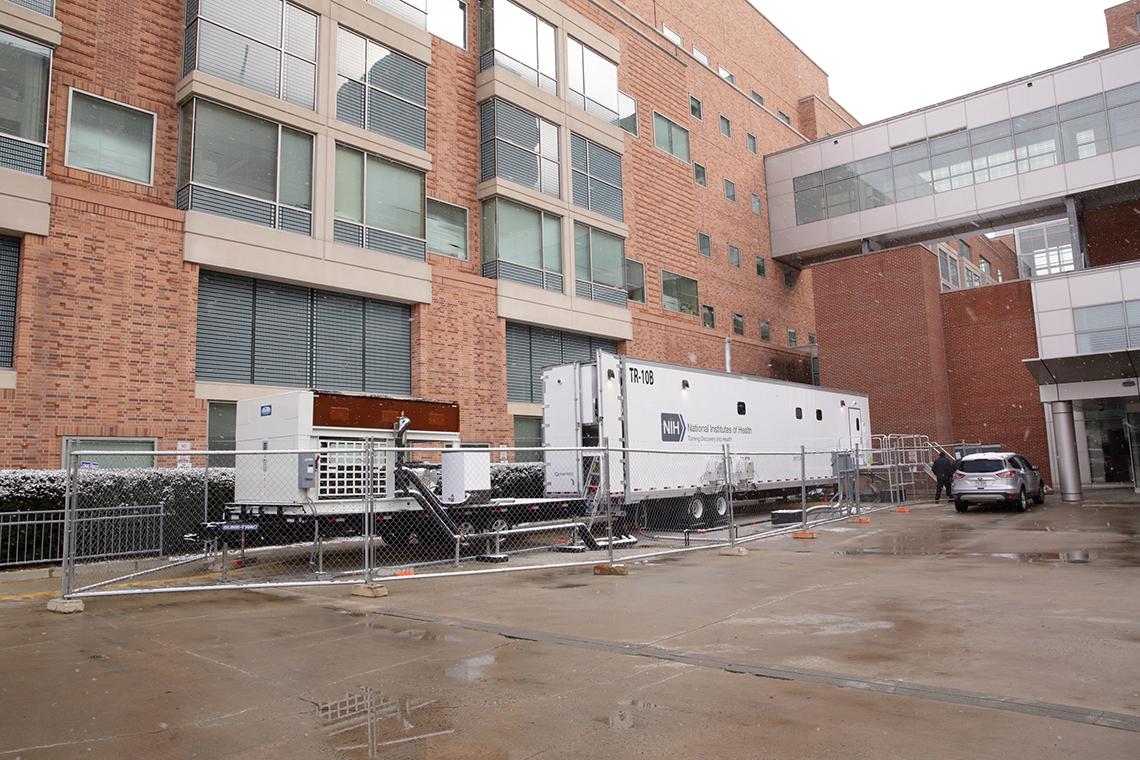Temporary Manufacturing Facility Parked at CRC

Photo: Ernie Branson
It’s not the site of a film crew and nobody’s living in it. But NCI investigators soon will spend long hours in a 53-foot trailer parked by the ambulance entrance on the west side of the Clinical Research Center. And more trailers are on order or in the design phase.
From the outside, the white trailer bearing NIH’s logo looks plain, but this is no ordinary rig. The aseptic, state-of-the-art module is a mini version of a large, sterile product manufacturing facility, explained Kurt Last, executive vice president of WorkingBuildings Group. His team supported NIH’s Office of Research Facilities by designing the module and worked with NCI to specify the manufacturing equipment in it. They’re now busy testing the controls, support systems and software so Trailer 1 is ready to spring into service in April.
Trailer 1, officially labeled CC TR 10B, will be used by NCI’s Surgery Branch to engineer immune cells for cancer therapy. At least three more modules are planned to help fulfill NIH’s sterile product and cell-processing needs.
“The future trailers are intended to supplement part of the department of transfusion medicine, called the cell-processing section, which generates engineered cells for different studies,” said Dr. Andrew Griffith, deputy director of intramural clinical research.
The trailers provide a space-saving, compliant environment for investigators to develop and manufacture sterile products used in their studies. And, these modules offer a way to meet good manufacturing practice (GMP) standards.
“In [scientists’] laboratories, from a compliance standpoint, air purity, air flow and pressurization were fighting against [investigators] all the time and that increases the risk of product failure,” said Last. “When a facility works with you and provides the pristine environment and the equipment is working…that dramatically reduces the risk of product contamination and failure. It increases throughput…and it’s better for patient safety.”
Trailer 1, the viral vector unit, will be devoted to NCI’s immunotherapy research. The Surgery Branch will be developing retroviruses that enable them to introduce genes into cells to create new immunotherapies.
“The trailer is going to enable us to resume what I think is very high-priority research developing these new gene therapy approaches for cancer,” said Dr. Steven Rosenberg, chief of the branch. “We can now vigorously resume our studies in developing gene therapies for common epithelial cancers that kill over 90 percent of everyone who dies of cancer. So this trailer is going to be a major asset for us.”
Trailer 2, on order, will also support NCI research and serve as a backup to the CC pharmacy department. “We understand these trailers are unlikely to adequately support clinical research in these areas by themselves,” said Dr. Bill Dahut, NCI’s scientific director for clinical research. “There are planned renovations in the CC to help [which likely will take years to complete] so right now we’re looking to these trailers to support these activities on a grander scale.”

Photo: Ernie Branson
Both trailers are to be equipped with the HVAC system and tools to meet an emergency need for compounding standards for sterile products and hazardous medications in the event of an unplanned downtime of the CC pharmacy department clean room. In the event of an emergency in the hospital, the trailers would also provide an environment for compounding patient medications.
“Patients in the hospital need doses immediately,” said Last, “and the only place on campus to do that, other than the Clinical Center’s pharmacy, would be these trailers.”
At least two additional trailers are planned for cell-processing activities that will support the research of multiple ICs. “It’s about creating more qualified space to continue the science,” said Dondi Pulse-Earle, associate director for facilities, Office of Research Support and Compliance. “The plan is for strategic coordination of the work for all trailers to be fully operational and utilized.”
The software and controls in each trailer are designed for multiple users and uses, offering the flexibility to change quickly between programs by the day to accommodate different or shorter research protocols. Keeping operations running smoothly in the trailers will require a campaign manager to acquire the proper materials and oversee regulatory requirements, maintenance, cleaning and safety during and between protocols.

Photo: Ernie Branson
“Another fascinating challenge is trying to anticipate science that doesn’t exist yet using materials that don’t exist yet,” said Last. His team is working with PIs, IC directors and NIH senior leadership to anticipate changing needs so they can stay in front of the research curve.
“Nobody knows what the NIH is going to be doing 5 years from now,” he said. “These systems need to be available for these scientists to prove a concept if they come up with something new…so we can rapidly move researchers into these units and configure them for specialty use.”
And, the fact that the trailers are self-contained units prevents possible cross-contamination.
“Whatever PIs do in these modules, it can’t spread to the next clean room,” said Last. “This is a good idea for the long term for NIH because we don’t know what kind of science they’re going to develop.”
The additional trailers will be located next to the CC, though their exact location has not yet been determined. Another facility, the vacant Bldg. 53 (an old power substation) adjacent to Bldg. 13, is being retrofitted for NCI’s use.
“[The trailers provide] a short-term solution to close gaps,” said Last, “but also a long-term solution given their long life expectancy—of 10-12 years—to stand by as new, emerging manufacturing processes are developed.”
